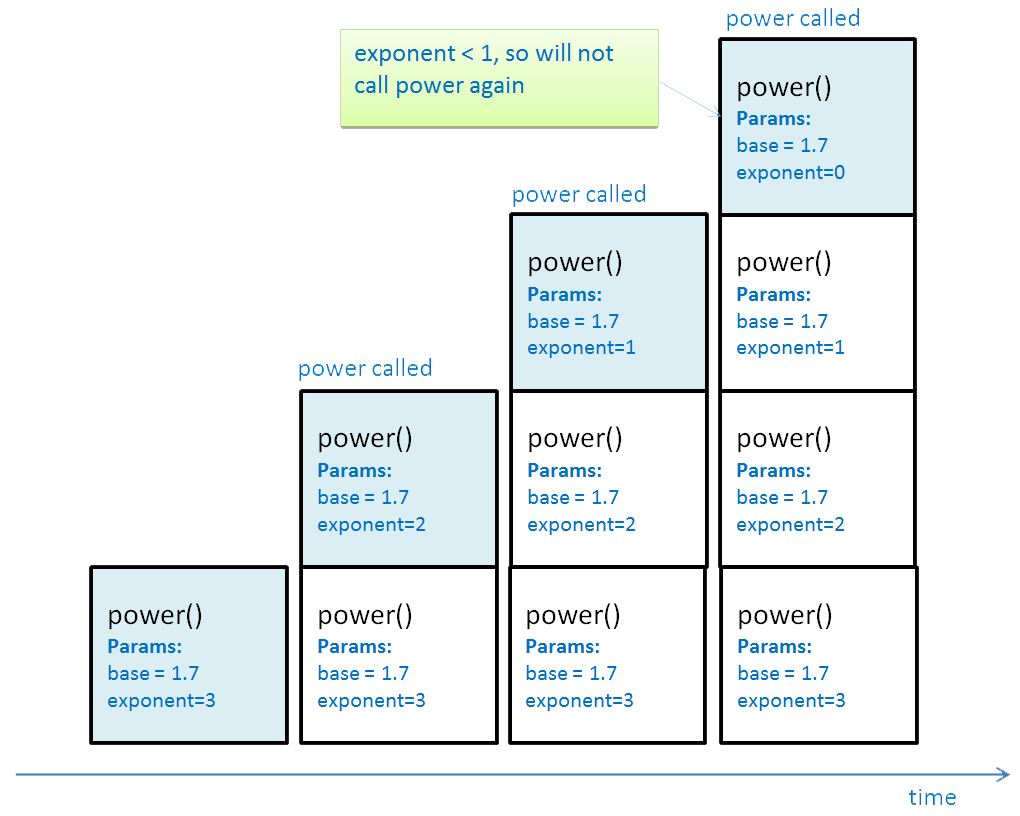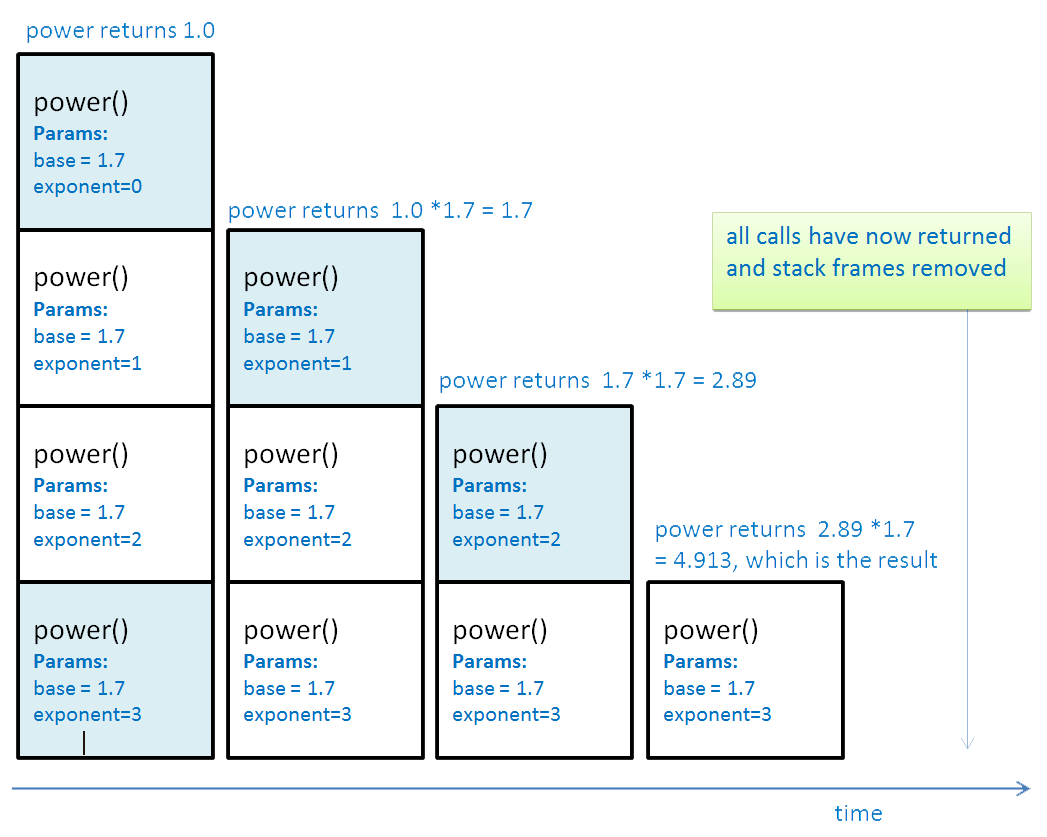-
Introduction
A recursive method calls itself in the method's body. This means that before the original method calls return, another call to the same method is issued from its body. This might seem a strange way of writing programs but very elegant solutions can be written using recursion.
Not all problems are amenable to a recursive solution. However, the following are the essential conditions for recursion:
a. A recursive call that acts on a smaller and smaller version of the original problem.
b. A terminating or base case, at which further recursion calls stop and the control/values start returning towards the first call to the method.
Failing to abide by above conditions can result in the method calling itself repeatedly as in an infinite loop.
- This week will:
- Understand how recursive solutions can be written
- Introduce some simple exercises of recursion
- Understand merge sort algorithm
In general any problem that can be solved by recursion can also have an iterative solution. Very elegant solutions can be written using recursion, such as for tree traversals as would be covered later on.
-
Recursion
In computer programming, recursion is concerened with the ability of a function (or subroutine) to call itself.
Factorial Function
On of the best known recursive functions is the factorial function. This is defined as:
$n! = (n)(n-1)(n-2)...(2)(1)$
$ = (n)(n-1)!$
also $(n-1)! = (n - 1)(n - 2)!$ and so on
Example
$3! = (3)(2)(1) = 6$
$4! = (4)(3!) = (4)(6) = 24$
$5! = (5)(4!) = (5)(24) = 120$
Now as the factorial function is a function we have values for $0!$ and $1!$.
$0! = 1$
$1! = 1$
The factorial function is a special case of the gamma function where $T(n) - nT(n-1)$.
-
Programming a Factorial Function
We might have an intial attempt at writing code as follows:
declare function factorial $(int n)$
return $n \times$ factorial $(n -1)$
If this psuedo code is tested, then we would have for example for $n = 3$:

Clearly, there is a problem, as there is no end to the call of the function, the computer would eventually run out of stack space and crash
-
We need a halting case ( or base case ) and we need to deal with incorrect input.
The $n$ in the factorial function should not be less than $0$. If it is, an error value can be returned. Also 0! = 1 and 1! = 1.
So psuedo code could look like:
declare function factorial $(int\; n)$
if $n < 0$ the return $0$ // error code
else if $n = 0$ or $n = 1$ return $1$
else return $n \times$ factorial $(n - 1)$
Now if we look at some examples
factorial $(-4) = 0$; return $0$, so it is an error
factorial $(0) = 1$
factorial $(1) = 1$
factorial $(4) = (4)(3)(2)(1) = 24$
-
A Recursive Power Function
Computes an integer power of a floating point number
double power(double base, int exponent) { if (exponent < 1) { return 1.0; } else { return power(base, exponent-1) * base; } }The function is called as follows:
System.out.println( power(1.7, 3) );
- Initial bindings
- base = 1.7
- exponent = 3
This diagram shows how the contents of the call stack change as recursive calls are made. Each time power executes, it makes another call to power, and pushes a new stack frame to the call stack. The value of the exponent parameter is different each time – look at the code to see why. At the fourth call, exponent is now < 1, so the other branch of the if statement executes and power is not called again. This is the stopping condition – without it the recursion would go on forever!
Call stack with recursive calls

In the fourth call, power returns 1.0 and that frame is popped from the stack. Execution returns to the third call, which returns the result of calculating:
power(base, exponent-1) * base
which is:
value returned by fourth call * base
= 1.0 * 1.7
= 1.7Now the third frame is popped from the stack and execution returns to the second call, which in turn returns the result of calculating:
value returned by third call * base
= 1.7 * 1.7
= 2.89Now the second frame is popped from the stack and execution returns to the first call, which in turn returns the result of calculating:
value returned by second call * base
= 2.89 * 1.7
= 4.913- Each return does the following:
- Pops a frame off of the stack
- Restores its data state
- Replaces the call to power with the return value
- Continues execution at the return address
Call stack as recursive calls return

Recursion and RAM
Recursive functions may require more space in memory than non-recursive calls. With some deeply recursive algorithms this can be a problem. It is possible to run out of memory space on the stack – stack overflow.
It can also be a problem with poorly written recursive functions with bad stopping condition definitions (result is like an infinite loop only on the stack)
Advantages of recursion
Recursion’s big advantage is the elegance with which it embodies the solution to many problems
It closely follows the mathematical definition of many functions
This makes it easier to prove correctness
Some problems are much easier to solve recursively than iteratively, e.g. Towers of Hanoi
- Disadvantages of recursion
- Use of system resources slows the process down compared to iterative solutions, although this may not be a big factor on modern machines
- Possibility of stack overflow
- Difficult to ‘think recursively’
-
Fibonacci Numbers
The Fibonacci number are also recursive.
The numbers start as follows:
$1, 1, 2, 3, 5, 8, 13, \cdots$
Now the first number $f_1 = 1$, the second number $f_2 = 1$.
The third number is formed as follows:
$f_3 = f_2 + f_1 = 1 + 1 = 2$
The fourth number is:
$f_4 = f_3 + f_2 = 2 + 1 = 3$
In general,
$f_n = f_{n-1} + f_{n-2}$
Strangely though, these numbers appear in computing and in biology in a natrual way.
-
Merge Sort
The sorting process is used to arrange the items in a collection, for example an array, in an increasing or decreasing order. Sorting algorithms would be covered in Week 6 and 7 but here we study Merge sort, a very efficient sorting algorithm that is based on divide-and-conquer technique nicely implemented using recursion.
Merge sort has a time complexity of Ο(n log n).
Merge sort has two steps, divide and merge:
1) The array is divided into equal halves and this halving process is performed recursively until an array of size one results; an only item in an array is already sorted.
2) The merging step is then performed that combines two array halves (that have already been sorted) into one larger array, ultimately combining the whole array by merging (and thus sorting the original array).
- This merge sort algorithm can be expressed as,
- Divide the array in two halves
- Merge sort the first half
- Merge sort the second half
- Merge the two halves
-
Psuedocode
mergeSort ( array arr of size n ) { if ( n == 1 ) return arr left_arr = arr[0] to arr[n/2] right_arr = arr[n/2+1] to arr[n] left_arr = mergeSort( left_arr ) right_arr = mergeSort( right_arr ) return merge( left_arr, right_arr ) } merge(leftarr as array, rightarr as array) { resultarr as array while ( length(leftarr) > 0 and length(rightarr) > 0) if(smallest item in leftarr < smallest item in rightarr) add (smallest item in leftarr) to resultarr remove (smallest item from leftarr) else add (smallest item in rightarr) to resultarr remove (smallest item from rightarr) if length(leftarr) > 0 add leftarr to resultarr if length(rightarr) > 0 add rightarr to resultarr return resultarr } -
Recursive Calls in Merge Sort
The array is recursively divided into two halves until both halves consist of only a single item, which can be considered sorted. At this point, the merge is performed that puts the items from both halves in a sorted order. This merge process is repeated until whole of the array is sorted.

-
Summary
- Recursion is a problem-solving technique where a method calls itself again and again on progressively smaller version of the original problem.
- A recursive solution must have a terminating or base case at which point no further method calls are made.
- Recursion can result in very simple and elegant solutions.
- Recursive solutions are slower and require more memory compared to iterative solutions due to maintaining the call stack.
- Merge sort is an efficient sorting algorithm which uses a divide-and-conquer strategy.